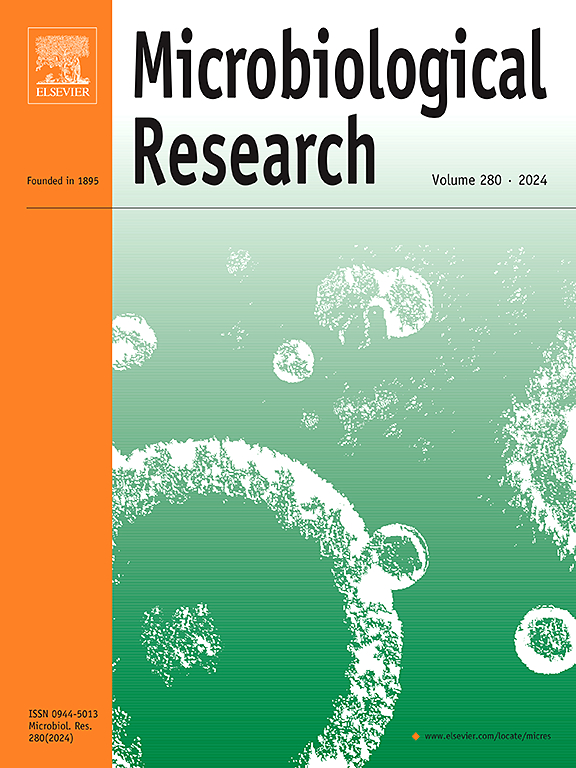Evolution and transmission potential of iuc3-positive virulence plasmids in hypervirulent Klebsiella pneumoniae
IF 6.9
1区 生物学
Q1 MICROBIOLOGY
引用次数: 0
Abstract
The global emergence of hypervirulent Klebsiella pneumoniae (hvKP) poses significant threats to public health. The iucABCD (iuc) operon, a plasmid-borne genetic determinant encoding the siderophore aerobactin, serves as a reliable biomarker for hvKP identification. This study aimed to characterize the iuc3 (type 3 iuc)-positive K.pneumoniae isolates from diseased cows as hvKP strains and to elucidate the contribution of iuc3-positive plasmids to the hypervirulence phenotype, the evolutionary pathways and the spreading risk of the iuc3-positive plasmids. Eight of 108 K. pneumoniae isolates from 763 cow milk samples contained the iuc3 operon, and all iuc3 operons were located on T4SS-bearing plasmids. Notably, these isolates showed hypervirulent phenotype compared to the iuc3 knockout and plasmid-cured strains, including severe tissue damage, high bacterial loads in typical organs and high mortality in animal models. Analysis of NCBI database showed iuc3-positive K. pneumoniae strains have been widely distributed across animal, food, and humans, and exhibit an independent evolutionary pathways compared to the human-associated iuc1-type hvKP. The IS elements likely drive the acquisition of various resistance genes and the emergence of iuc3-positive resistance plasmids. The iuc3-bearing plasmids in this study demonstrated highly conjugative ability, low fitness costs, and the ability to replace the iuc1-bearing classical virulence plasmid in human hvKP strain. Besides, they could completely fuse with broad-host-range resistance plasmid (IncX3-blaNDM-5), becoming carbapenem-resistant hvKP strains. The iuc3- and blaNDM-5- fusion plasmids showed strong in vivo retention and dissemination capabilities in mouse models. Our findings emphasize the necessity for long-term monitoring of iuc3-positive plasmids in K. pneumoniae isolates from both animals and humans.
高致病性肺炎克雷伯菌iuc3阳性毒力质粒的进化和传播潜力
全球出现的高致病性肺炎克雷伯菌(hvKP)对公共卫生构成重大威胁。iucABCD (iuc)操纵子是一种质粒携带的遗传决定因子,编码铁载体有氧肌动蛋白,可作为hvKP鉴定的可靠生物标志物。本研究旨在将iuc3(3型iuc3)阳性的病牛肺炎克雷伯菌分离株定性为hvKP菌株,并阐明iuc3阳性质粒对高毒力表型的贡献、iuc3阳性质粒的进化途径和传播风险。108个中的8个 从763份牛奶样品中分离出的肺炎菌均含有iuc3操纵子,且iuc3操纵子均位于含t4ss的质粒上。值得注意的是,与iuc3敲除菌株和质粒固化菌株相比,这些分离株表现出高毒力表型,包括严重的组织损伤,典型器官中的高细菌负荷和动物模型中的高死亡率。NCBI数据库分析显示,与人类相关的iuc1型hvKP相比,iuc3阳性肺炎克雷伯菌菌株在动物、食物和人类中广泛分布,并表现出独立的进化途径。IS元件可能驱动各种抗性基因的获得和iuc3阳性抗性质粒的出现。本研究中携带iuc3的质粒在人hvKP株中表现出高共轭能力、低适应度成本,并且能够取代携带iuc1的经典毒力质粒。此外,它们可以与广宿主抗性质粒(IncX3-blaNDM-5)完全融合,成为耐碳青霉烯的hvKP菌株。iuc3-和blaNDM-5-融合质粒在小鼠模型中表现出较强的体内保留和传播能力。我们的发现强调了长期监测从动物和人类分离的肺炎克雷伯菌中iuc3阳性质粒的必要性。
本文章由计算机程序翻译,如有差异,请以英文原文为准。
求助全文
约1分钟内获得全文
求助全文
来源期刊

Microbiological research
生物-微生物学
CiteScore
10.90
自引率
6.00%
发文量
249
审稿时长
29 days
期刊介绍:
Microbiological Research is devoted to publishing reports on prokaryotic and eukaryotic microorganisms such as yeasts, fungi, bacteria, archaea, and protozoa. Research on interactions between pathogenic microorganisms and their environment or hosts are also covered.
 求助内容:
求助内容: 应助结果提醒方式:
应助结果提醒方式:


